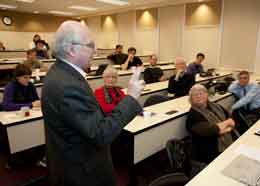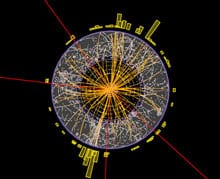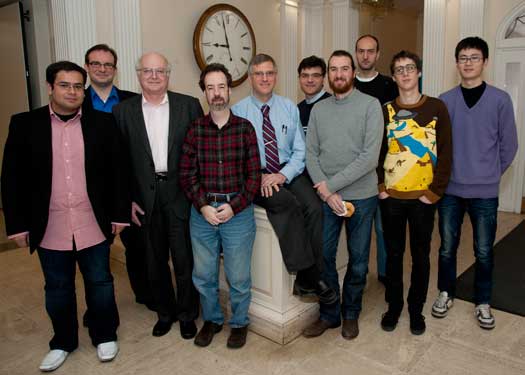Using different search techniques, Tevatron physicists see hints of Higgs boson sighting consistent with those from LHC
New measurements announced March 7 by scientists from the CDF and DZero collaborations at the Department of Energy’s Fermi National Accelerator Laboratory indicate that the elusive Higgs boson may nearly be cornered.
After analyzing the full data set from the Tevatron accelerator, which completed its last run in September 2011, the two independent experiments see hints of a Higgs boson.
The new results from Fermilab signify that it’s increasingly difficult to ignore the existence of the Higgs boson, said physicist Robert Kehoe, a professor at Southern Methodist University, who is a scientist on one of the Fermilab experiments that announced the results.
“The Higgs is a fundamental particle theorized about 40 years ago to give matter to the mass that we observe, and which scientists have tried to observe for decades,” Kehoe said. “This is a hint that it exists. It doesn’t establish a discovery. But it lends a little more credence to the theory that there is something there. Anyone trying to say there isn’t a Higgs particle — the data are having a harder time backing that up.”
SMU students who are also participating in the DZero experiment at Fermilab include physics graduate students HuanZhao Liu and Yuriy Ilchenko; SMU postdoctoral researchers Peter Renkel and Amitabha Das; and undergraduate physics student Jason South.
If scientists from CERN and Fermi can confirm in the near future a discovery of the Higgs, that will validate the Standard Model of fundamental particles and interactions, which summarizes current knowledge in particle physics.
“At this point we’ve seen a hint that we may someday observe the long lost Standard Model family member,” said SMU’s Liu.
“No doubt, we live in a very exciting and thrilling historical moment,” said Ilchenko. “The new Higgs results and a promising discovery will not only solve the centuries-old mystery of origin of mass but also highlight a victory of science and the triumph of humanity as a whole.”
Click to read: Frequently asked questions about the Higgs boson.
Data could indicate a Higgs boson with mass similar to CERN data
The Fermilab results are similar in statistical significance to those presented by the Large Hadron Collider at the CERN particle collider in Europe, which in December announced hints of the Higgs boson.
At Fermilab, physicists from the CDF and DZero collaborations found excesses in their data that might be interpreted as coming from a Higgs boson with a mass in the region of 115 to 135 GeV. In this range, the new result has a probability of being due to a statistical fluctuation at level of significance known among scientists as 2.2 sigma. This new result also excludes the possibility of the Higgs having a mass in the range from 147 to 179 GeV.
Physicists claim evidence of a new particle only if the probability that the data could be due to a statistical fluctuation is less than 1 in 740, or three sigmas. A discovery is claimed only if that probability is less than 1 in 3.5 million, or five sigmas.
This result sits well within the stringent constraints established by earlier direct and indirect measurements made by CERN’s Large Hadron Collider, the Tevatron, and other accelerators, which place the mass of the Higgs boson within the range of 115 to 127 GeV. These findings are also consistent with the December 2011 announcement of excesses seen in that range by LHC experiments, which searched for the Higgs in different decay patterns.
Jury still out on confirmation of Higgs
None of the hints announced so far from the Tevatron or LHC experiments, however, are strong enough to claim evidence for the Higgs boson.
“The end game is approaching in the hunt for the Higgs boson,” said Jim Siegrist, DOE Associate Director of Science for High Energy Physics. “This is an important milestone for the Tevatron experiments, and demonstrates the continuing importance of independent measurements in the quest to understand the building blocks of nature.”
Physicists from the CDF and DZero experiments made the announcement at the annual conference on Electroweak Interactions and Unified Theories known as Rencontres de Moriond in Italy. This is the latest result in a decade-long search by teams of physicists at the Tevatron.
“I am thrilled with the pace of progress in the hunt for the Higgs boson. CDF and DZero scientists from around the world have pulled out all the stops to reach this very nice and important contribution to the Higgs boson search,” said Fermilab Director Pier Oddone. “The two collaborations independently combed through hundreds of trillions of proton-antiproton collisions recorded by their experiments to arrive at this exciting result.”
Higgs bosons, if they exist, are short-lived and can decay in many different ways. Just as a vending machine might return the same amount of change using different combinations of coins, the Higgs can decay into different combinations of particles. Discovering the Higgs boson relies on observing a statistically significant excess of the particles into which the Higgs decays and those particles must have corresponding kinematic properties that allow for the mass of the Higgs to be reconstructed.
“There is still much work ahead before the scientific community can say for sure whether the Higgs boson exists,” said Dmitri Denisov, DZero co-spokesperson and physicist at Fermilab. “Based on these exciting hints, we are working as quickly as possible to further improve our analysis methods and squeeze the last ounce out of Tevatron data.”
High-energy particle colliders recreate the Big Bang’s energy
Only high-energy particle colliders such as the Tevatron and LHC can recreate the energy conditions found in the universe shortly after the Big Bang. According to the Standard Model, the theory that explains and predicts how nature’s building blocks behave and interact with each other, the Higgs boson gives mass to other particles.
“Without something like the Higgs boson giving fundamental particles mass, the whole world around us would be very different from what we see today,” said Giovanni Punzi, CDF co-spokesperson and physicist at the National Institute of Nuclear Physics, or INFN, in Pisa, Italy. “Physicists have known for a long time that the Higgs or something like it must exist, and we are eager to finally pin this phenomenon down and start learning more about it.”
If a Higgs boson is created in a high-energy particle collision, it immediately decays into lighter more stable particles before even the world’s best detectors and fastest computers can snap a picture of it. To find the Higgs boson, physicists retraced the path of these secondary particles and ruled out processes that mimic its signal.
The experiments at the Tevatron and the LHC offer a complementary search strategy for the Higgs boson. The Tevatron was a proton/anti-proton collider, with a maximum center of mass energy of 2 TeV, whereas the LHC is a proton/proton collider that will ultimately reach 14 TeV.
Search strategies vary at the two accelerators
Because the two accelerators collide different pairs of particles at different energies and produce different types of backgrounds, the search strategies are different. At the Tevatron, for example, the most powerful method is to search the CDF and DZero datasets to look for a Higgs boson that decays into a pair of bottom quarks if the Higgs boson mass is approximately 115-130 GeV.
It is crucial to observe the Higgs boson in several types of decay modes because the Standard Model predicts different branching ratios for different decay modes. If these ratios are observed, then this is experimental confirmation of both the Standard Model and the Higgs.
“The search for the Higgs boson by the Tevatron and LHC experiments is like two people taking a picture of a park from different vantage points,” said Gregorio Bernardi, DZero co-spokesperson at the Nuclear Physics Laboratory of the High Energies, or LPNHE, in Paris.
“One picture may show a child that is blocked from the other’s view by a tree. Both pictures may show the child but only one can resolve the child’s features,” said Bernardi. “You need to combine both viewpoints to get a true picture of who is in the park. At this point both pictures are fuzzy and we think maybe they show someone in the park. Eventually the LHC with future data samples will be able to give us a sharp picture of what is there. The Tevatron by further improving its analyses will also sharpen the picture which is emerging today.”
Result represents years of work by hundreds of scientists
This new updated analysis uses 10 inverse femtobarns of data from both CDF and DZero, the full data set collected from 10 years of the Tevatron’s collider program. Ten inverse femtobarns of data represents about 500 trillion proton-antiproton collisions. Data analysis will continue at both experiments.
“This result represents years of work from hundreds of scientists around the world,” said Rob Roser, CDF co-spokesperson and physicist at Fermilab. “But we are not done yet – together with our LHC colleagues, we expect 2012 to be the year we know whether the Higgs exists or not, and assuming it is discovered, we will have first indications that it behaves as predicted by the Standard Model.”
CDF is an international experiment of 430 physicists from 58 institutions in 15 countries . DZero is an international experiment conducted by 446 physicists from 82 institutions in 18 countries . Funding for the CDF and DZero experiments comes from DOE’s Office of Science, the National Science Foundation, and a number of international funding agencies. — Fermilab and Southern Methodist University
Frequently Asked Questions About the Higgs Boson
Why should the average person care if the Higgs is found?
Understanding more about the building blocks of matter and the forces that control their interactions helps scientists to learn how to manipulate those forces to humankind’s benefit.For example, the study of the electron led to the development of electricity, the study of quantum mechanics made possible the creation of GPS systems and the study of the weak force led to an understanding of radioactive decay and nuclear power.
Now what?
The Tevatron experiments will continue to further analyze the Higgs boson data to wring out more information. In addition, the Tevatron and LHC experiments are working to combine their data for a release at an unspecified date.Even if both teams find evidence of a Higgs boson in the same location, physicists will need to do more analysis to make sure the Higgs boson isn’t a non-Standard Model Higgs masquerading as a resident of the Standard Model. That will require physicists to measure several properties in addition to mass.
What would finding the Higgs boson mean for the field of physics?
Finding evidence of the Higgs boson would expand the following three areas of study:
- Pin-pointing the mass range of the Higgs would help physicists condense the number of theories about the existence of undiscovered particles and the forces that interact on them. For example, a Standard Model Higgs boson would rule out classic QCD-like versions of technicolor theory.
A Higgs boson with a mass larger than 125 GeV would rule out the simplest versions of supersymmetry, or SUSY, which predict that every known particle has an unknown sibling particles with a different mass. Other theories would gain more support. One such SUSY theory predicts that a Standard Model Higgs boson would appear as the lightest of a group of five or more Higgs bosons. Whether the Higgs boson exists or not does not affect theories about the existence of extra dimensions.
- Knowing the mass of the Higgs boson would give physicists more data to plug into other equations about how our universe formed and about some of the least understood particle interactions, such as magnetic muon anomaly.
- Finding evidence of a heavy mass Higgs boson (larger than 150 GeV) would require the existence of undiscovered particles and/or forces. Finding a light mass Higgs boson (less than 125 GeV) would not require the existence of new physics but doesn’t rule it out either.
SMU is a nationally ranked private university in Dallas founded 100 years ago. Today, SMU enrolls nearly 11,000 students who benefit from the academic opportunities and international reach of seven degree-granting schools. For more information see www.smu.edu.
SMU has an uplink facility on campus for live TV, radio or online interviews. To speak with an SMU expert or to book them in the SMU studio, call SMU News & Communications at 214-768-7650 or UT Dallas Office of Media Relations at 972-883-4321.

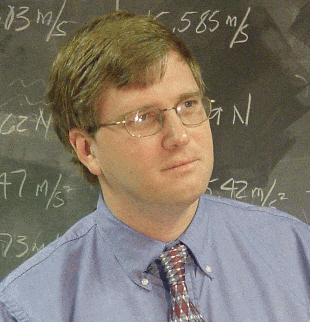
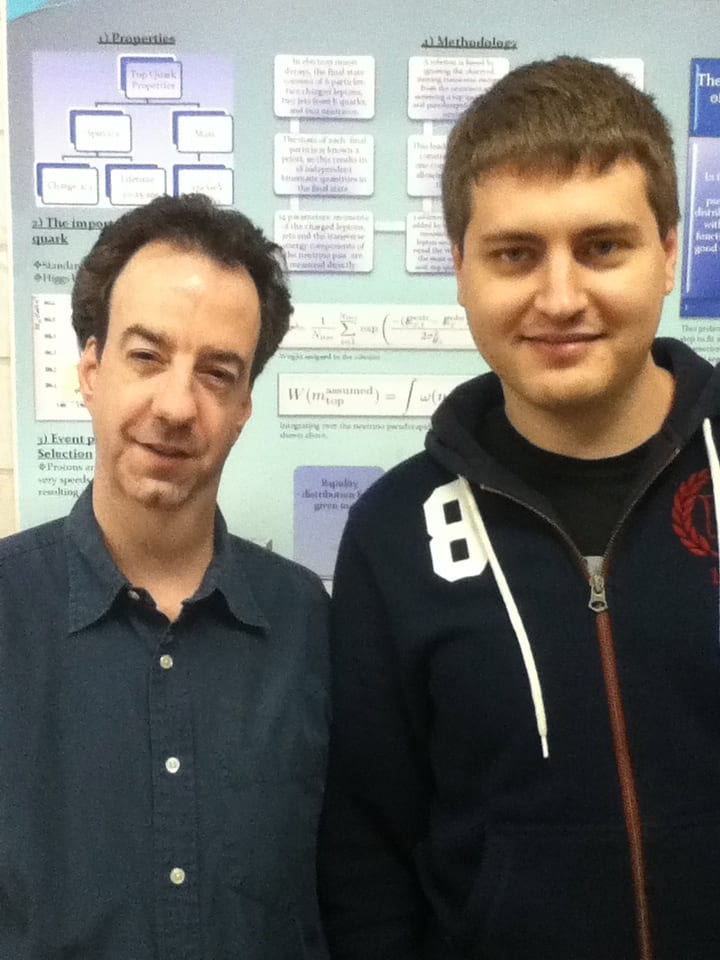



 Study: Nearly two-thirds of EU citizens are marginalized by English-language dominance
Study: Nearly two-thirds of EU citizens are marginalized by English-language dominance From ‘Green Card’ to ‘Thin Blue Line’: Lawtalk research looks at popular legal expressions
From ‘Green Card’ to ‘Thin Blue Line’: Lawtalk research looks at popular legal expressions Public health insurance provides insured infants better, less costly care than private plans
Public health insurance provides insured infants better, less costly care than private plans Many top US scientists wish they had more children, with men especially dissatisfied
Many top US scientists wish they had more children, with men especially dissatisfied Anthropology study finds that immigrants from India and Vietnam become American over time
Anthropology study finds that immigrants from India and Vietnam become American over time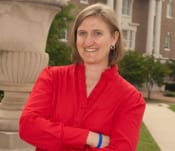
 Public health insurance provides insured infants better, less costly care than private plans
Public health insurance provides insured infants better, less costly care than private plans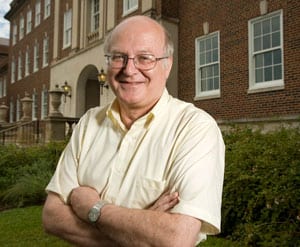
 A mathematical model determines which nations are more stable and which are more likely to break up
A mathematical model determines which nations are more stable and which are more likely to break up SMU to help solve dangerous refugee water issues
SMU to help solve dangerous refugee water issues Anthropology researcher to study human-fire-climate interactions
Anthropology researcher to study human-fire-climate interactions
